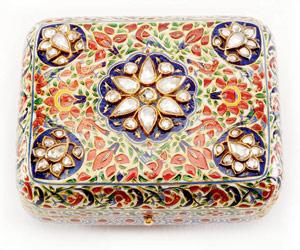Bernadette van Gelder wants the world to know the importance of Indian jewellery through her books


Gold enameled box set with diamonds, 1900/1910, from Jaipur: The box with its rounded corners and a hinged lid, is decorated in the centre with a translucent blue enameled rosette, which is bordered with light-blue lining and decorated with a raised gold rosette in the center, set with diamonds. Considering the Western appearance of the box, one may assume it was made on commission in Delhi, then inhabited by Europeans. pics/Traditional Indian Jewellery by Bernadette van Gelder
It was in the late seventies that Bernadette van Gelder, founder of Van Gelder Indian Jewellery, was gifted a suite of Chinese jewellery by her brother, Clemens van der Ven, who was a Chinese jewellery exporter. She was then told that to really appreciate the pieces, in 20k carat and depicting flowers carved out of stone, she needed to get to know more about the history behind it, and specifically about the country behind it.
ADVERTISEMENT

Gold Baju Band from North India, 19th century: The tradition of wearing this type of bracelets was inherited by the Mughals from their ancestors, the Timurids. They became more ornate through time and were symbolic of aristocracy and masculinity. They became more significant when nobility wore them to identify their role.
Instead of China, her research unexpectedly took her to India. "I instantly fell in love with its people, country and culture. I started travelling to India from the eighties onwards and learned all about the role of traditional Indian jewellery in the lives of its people. It's so different from what we are used to in Europe. I never get tired of being fascinated by the country," she tells us. It's this continued fascination that has led the Dutch entrepreneur writing and publishing Traditional Indian Jewellery: The Golden Smile of India & Beautiful People — a detailed two-volume publication, covering the rich heritage of Indian jewellery and its significance in Indian society, which will be released at the Gyan Museum in Jaipur today.

Nath from West Rajasthan, Barmer district, early 20th century: An elaborate gold bali or balu nose ring with its original chain which can be hooked to the hair or head cloth to give support the weight. The bali is decorated with different colours of irregular tourmaline beads, pearls and gold beads, and this style reflects the jewellery design of early Bukhara region in Uzbekistan. In Hinduism, the nose ring is a symbol of being married. Getting the nose pierced is also seen as paying respect to Goddess Parvati.
For the past 35 years, van Gelder, who established her company in the 1980s, has travelled the length and breadth of the country, which allowed her to meet and talk to goldsmiths, stone setters and enamellers. The books have been written to inform the world about Indian aesthetics and iconography, offering insights into the role of jewellery in everyday life, festivals and religion. The ordinary Indian could also gain to read the books as many of us don't dwell on why we wear what we wear, as it's being passed down for centuries. Many of her insights were aided by the Late Gyan Chanda Dhaddha, in whose memory Gyan Museum was opened — which houses his collection of objet d'art from around the world, dating back over 3,000 years — and who became van Gelder's guide and mentor in India. The books also focus on the woman wearing the jewellery, shedding light on the fact that these gems were worn as a symbol of their strength and health.
"Through the tradition in the different states and regions of how jewellery is worn, women are shown to be strong and powerful. The books also try and say that in India, people consider their body as a temple, and as the temple and its deities in it, you have to decorate your body, this is what they do with jewellery — be it women, men and children. This is very different from Europe," she says.
The family-run business, which is now run by van Gelder and her daughters, Fleur Damman-van Gelder and Noelle Viguurs-van Gelder, has grown to be one of the leading international dealers in this field today. As van Gelder says, in Europe, buyers don't just see these pieces as jewellery, but as the carriers of history and traditions of India. "Every piece has a story, the meaning of the use of stones like the nava ratna, where a piece is worn on the body and why. Talking to people in Europe about these pieces opens up an entire world that one is not always familiar with."
Download the new mid-day Android and iOS apps to get updates on all the latest and trending stories on the go
 Subscribe today by clicking the link and stay updated with the latest news!" Click here!
Subscribe today by clicking the link and stay updated with the latest news!" Click here!







